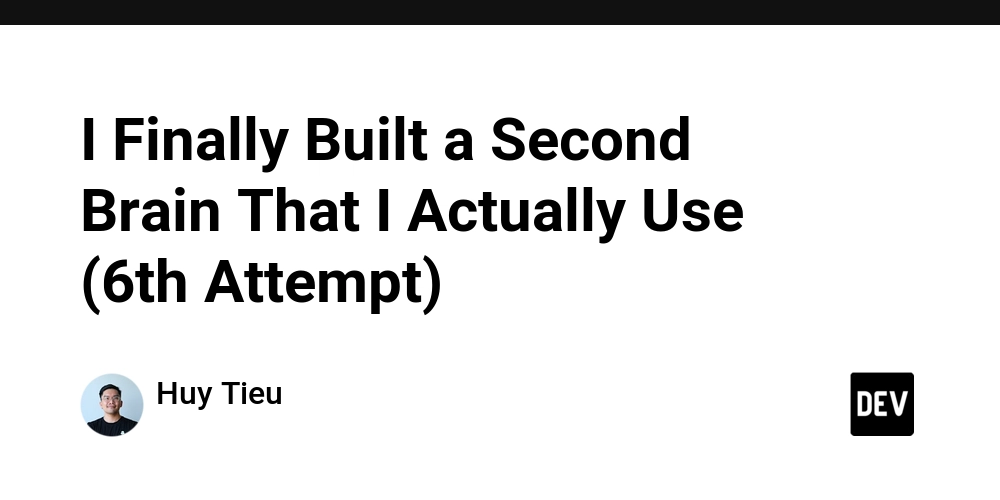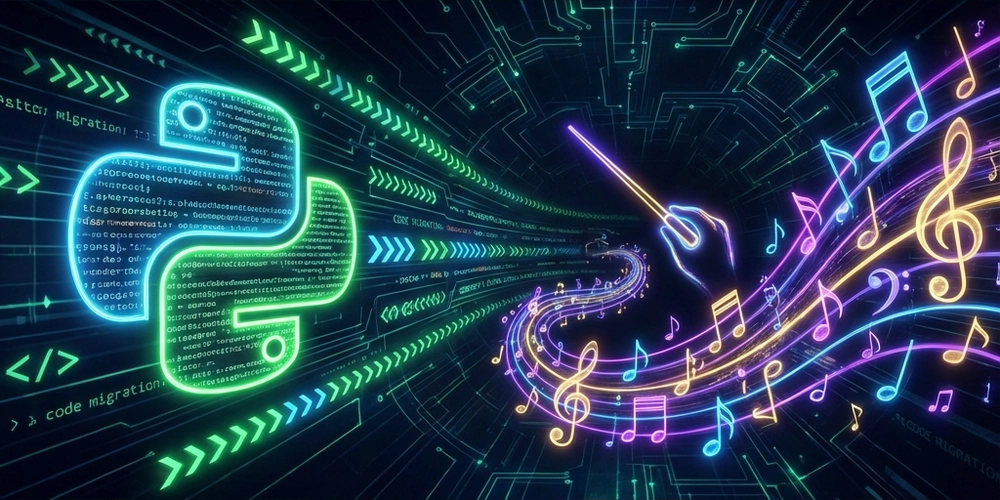I have a graveyard of abandoned “second brain” projects:
- Notion (abandoned after 3 weeks)
- Obsidian + 20 plugins (1 month, then overwhelming)
- Custom React app (never finished)
- Another Notion attempt (1 week)
The pattern was always the same: initial excitement → capture lots of notes → manual organization becomes overwhelming → abandon ship.
This time, I tried something different: I made AI do all the boring parts.
Three months later, I’m still using it. First time that’s happened.
What is COG?
COG = Claude + Obsidian + Git
It’s a self-organizing second brain system where:
- You dump messy thoughts
- AI organizes them automatically
- Everything is plain markdown files
- Zero manual maintenance required
GitHub Repo | MIT Licensed
The Problem I Kept Hitting
Every second brain system expects you to:
- Capture thoughts in a structured way
- File them in the right place
- Tag them appropriately
- Review and reorganize regularly
- Build frameworks manually
I’m great at #1. I’m terrible at #2-5.
After my 5th failed attempt, I realized: I don’t need another note-taking app. I need an AI that organizes my mess.
How COG Actually Works
Daily Usage
Morning: Intelligence Briefing
/daily-brief
Claude searches for verified news (last 7 days only), analyzes it based on my interests (learned from my notes), and generates a personalized briefing.
Output example:
# Daily Brief - October 15, 2025
## Executive Summary
**Priority Focus Areas**: AI Testing Tools | Browser Automation
[Strategic analysis based on my projects...]
## Strategic News
### AI Testing Market Reaches 72% Adoption
[Verified sources, dated within 7 days, with strategic implications]
## Opportunities
1. Integration with [project I'm working on]
2. [Specific next steps based on news]
Throughout Day: Brain Dumps
/braindump
No structure needed. Just dump whatever:
Random thought: The AI testing market is crazy right now.
Saw Ghostship raised $5M. Maybe we should pivot focus?
Also need to follow up with Duke about the feedback.
Idea: What if we auto-detect competitors in braindumps?
COG automatically:
- Classifies domain (personal/professional/project)
- Detects competitive intelligence (“Ghostship raised $5M”)
- Updates
04-projects/my-project/competitive/ghostship.md - Cross-references to this braindump
- Flags action items (“follow up with Duke”)
Weekly: Pattern Recognition
/weekly-checkin
Claude analyzes ALL content from the week:
- What themes emerged?
- What patterns in energy/productivity?
- How did personal wellness affect work?
- What needs attention next week?
Monthly: Knowledge Synthesis
/consolidate-knowledge
This is where the magic happens.
Claude reads every braindump since last consolidation and:
- Identifies recurring themes
- Synthesizes scattered insights into frameworks
- Updates “single source of truth” knowledge docs
- Tracks evolution of thinking over time
Real example:
I had 40+ scattered braindumps about my testing automation project over 3 months. Random thoughts, meeting notes, competitive intel, technical ideas—complete chaos.
Ran /consolidate-knowledge.
Output: A coherent 15-page strategic analysis with:
- Competitive landscape synthesis
- Technical architecture patterns
- Market positioning framework
- Product roadmap priorities
I used this doc to pitch investors. I didn’t manually compile any of it.
The Tech Stack
Why These Choices?
Obsidian (Markdown Storage)
- Plain
.mdfiles = no vendor lock-in - Works with any text editor
- Grep-able, searchable, future-proof
- Obsidian mobile works great
Claude Code (AI Engine)
- Better at synthesis than ChatGPT (for my use case)
- Can read entire vault context
- Custom slash commands = no copy-paste workflow
- Learns patterns over time
Git (Version Control)
- See thinking evolution:
git log - Undo bad consolidations:
git revert - Branch for experiments
- Full backup history
iCloud (Sync)
- Instant sync to iPhone/iPad/Mac
- Obsidian mobile works perfectly
- No special setup needed
Setup (Literally 3 Minutes)
Prerequisites
Installation
# Clone into your Obsidian vault
cd /path/to/your/obsidian-vault
git clone https://github.com/huytieu/COG-second-brain.git
# Copy COG files
cp -r COG-second-brain/.claude .
cp -r COG-second-brain/templates ./06-templates
# Open Claude Code
code .
# Test it
/braindump
That’s it. Your second brain is running.
Directory Structure
COG creates this structure automatically:
your-vault/
├── .claude/
│ ├── commands/ # 15 custom slash commands
│ └── subagents/ # 5 specialized AI agents
├── 00-inbox/ # Temporary processing
├── 01-daily/
│ ├── briefs/ # Daily intelligence
│ └── checkins/ # Daily reflections
├── 02-personal/ # Personal domain (strict privacy)
│ ├── braindumps/
│ ├── development/
│ └── wellness/
├── 03-professional/ # Professional domain
│ ├── braindumps/
│ ├── leadership/
│ └── strategy/
├── 04-projects/ # Project-specific tracking
│ └── [your-project]/
│ ├── braindumps/
│ ├── competitive/ # Auto-updated intel
│ └── content/
├── 05-knowledge/ # Consolidated insights
│ ├── consolidated/ # "Single source of truth"
│ ├── patterns/ # Recurring themes
│ └── timeline/ # Thinking evolution
└── 06-templates/ # Obsidian templates
What Makes It “Self-Evolving”?
Most PKM systems are static storage. You put notes in, you search later.
COG is active intelligence. It:
1. Auto-Classifies Content
Mention “workout routine” → Goes to 02-personal/wellness/
Mention “team leadership” → Goes to 03-professional/leadership/
Mention “project milestone” → Goes to 04-projects/[name]/
2. Detects Competitive Intelligence
Mention “Competitor X raised funding” in any braindump:
- Extracts to
04-projects/[project]/competitive/competitor-x.md - Adds dated entry
- Cross-references source braindump
- No manual filing needed
3. Builds Frameworks You Didn’t Create
Weekly consolidation synthesizes patterns:
- “You’ve mentioned ‘testing bottlenecks’ 8 times this month”
- “Here’s a framework based on those insights”
- “This connects to your Q3 goals from May”
4. Self-Heals Cross-References
Rename project-alpha.md → scout-ai.md?
COG updates all references automatically in next consolidation.
5. Learns Your Patterns
After 3 months, COG knows:
- When you’re most productive (Git history + energy logs)
- What topics you care about (frequency analysis)
- How your thinking evolved (timeline tracking)
- What questions you repeatedly ask
Real Results After 3 Months
Quantifiable:
- 120+ braindumps processed
- 5 strategic frameworks built (from scattered insights)
- Daily briefs with 95%+ source accuracy
- 0 manual organization required
- 0 maintenance overhead
Qualitative:
- Actually using it (first time ever)
- Strategic insights I wouldn’t have found manually
- Investor pitch doc synthesized from chaos
- Cross-domain patterns (wellness → productivity correlation)
- Thinking evolution timeline (see how I changed my mind)
What Makes This Different from…
ChatGPT?
ChatGPT requires manual copy-paste every time. COG knows your entire vault context and runs automatically on schedule.
Obsidian Plugins?
Plugins still require manual configuration and organization. COG is opinionated—works out of the box with zero setup.
Notion AI?
Notion locks you in. COG is plain text files. Also, Notion AI doesn’t build frameworks from scattered insights—it just answers questions.
Roam Research?
Roam is amazing for linking. COG adds synthesis—it doesn’t just link notes, it builds frameworks from them.
Lessons Learned Building This
What Worked
1. Let AI do what I hate
Organizing, tagging, cross-referencing = soul-crushing for me. Let Claude do it.
2. Plain text files
Every complex system I built failed. .md files survived.
3. Git for thoughts
Seeing git log of my thinking evolution is weirdly powerful. You realize how much your mind changes.
4. On-demand processing
Don’t process every note automatically. Process weekly when I run consolidation. Less noise.
What Didn’t Work
1. Too many commands initially
Started with 25 commands. Overwhelming. Now I use 4 regularly.
2. Perfect categorization
Tried to build perfect taxonomy. Failed. Now: personal/professional/projects. Done.
3. Manual review workflows
Tried “review queue” systems. Never used them. Consolidation handles review automatically.
Surprising Benefits
1. It’s a thinking partner
Writing braindumps knowing they’ll be analyzed makes me think more clearly.
2. Pattern recognition
Git history showed I brainstorm best Tuesday mornings. Would never notice manually.
3. Cross-domain insights
COG connects personal wellness to professional productivity quantitatively. Mind-blowing.
4. Actually maintenance-free
I legitimately haven’t “maintained” this in 6 weeks. It just… works.
Privacy & Cost Considerations
Privacy
Concern: “You’re sending all your notes to Claude?”
Reality:
- COG only sends content when you invoke commands
- It’s on-demand, not continuous background processing
- For sensitive content, keep separate vault or use local AI (Ollama)
- You control what gets processed
Cost
Claude API usage for my workflow:
- Daily briefs: ~$0.10/day = $3/month
- Weekly consolidation: ~$2-3/consolidation = $8-12/month
- Misc braindumps: ~$2/month
Total: $10-15/month
Compare to Notion AI ($10/month) or Roam ($15/month) but with full ownership of data.
Common Questions
“Do I need to know coding?”
Nope. Just basic terminal commands (copy files, run commands). The setup instructions are copy-paste.
“Can I customize it?”
Yes! Edit .claude/commands/*.md files to change how commands work. They’re just markdown files with prompts.
“What if Claude Code goes away?”
The commands are just text files. Port them to any AI system (local Ollama, OpenAI API, etc.). Your data is just .md files—completely portable.
“Does it work offline?”
Partially. You can read/edit notes offline. AI commands require internet for Claude API. Could be adapted for local LLMs.
“How do I migrate my existing notes?”
Drop them in the appropriate folders (02-personal/, 03-professional/, etc.). Run /consolidate-knowledge and COG will process them.
Try It Yourself
If you’ve also failed at maintaining a second brain, maybe this approach works for you:
1. Clone the repo:
git clone https://github.com/huytieu/COG-second-brain.git
2. Follow SETUP.md
3. Start with just two commands:
-
/braindump(capture thoughts) -
/consolidate-knowledge(organize weekly)
4. Customize as needed
What’s Next
Ideas I’m considering:
- [ ] Local LLM support (Ollama) for privacy
- [ ] Web interface for knowledge graph visualization
- [ ] Mobile-optimized commands (for Obsidian mobile)
- [ ] Team collaboration features (with privacy)
- [ ] Voice-to-braindump (for mobile capture)
Final Thoughts
I don’t know if COG is the “right” way to build a second brain. But it’s the first system I’ve actually maintained for 3 months.
The insight: Stop trying to organize thoughts manually. Let AI do it.
Humans are great at:
- Having ideas
- Seeing patterns in synthesized data
- Making decisions
Humans are terrible at:
- Consistent filing
- Cross-referencing
- Pattern detection across 100+ documents
- Remembering where we put that thing 6 weeks ago
Let AI do the terrible parts. You do the human parts.
If you’ve struggled with this too, give it a shot:
🔗 GitHub: https://github.com/huytieu/COG-second-brain
📄 License: MIT (free, open source)
⏱️ Setup time: 3 minutes
💰 Cost: $10-15/month (Claude API)
Discussion: What’s your second brain graveyard look like? What systems have you tried and abandoned? I’d love to hear what worked/didn’t work for you.
P.S. If you try COG, I’d love feedback. Open issues/discussions on GitHub or comment below!



